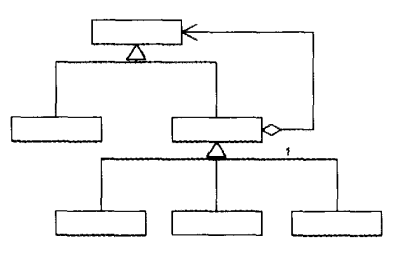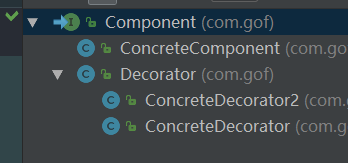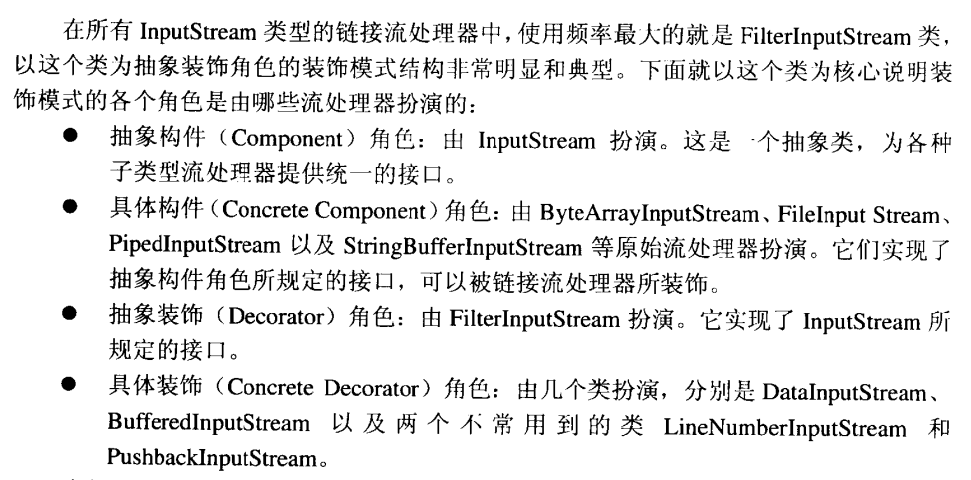一、概述
动态地给一个对象添加一些额外的职责。就增加功能来说, Decorator模式相比生成子类更为灵活。该模式以对客 户端透明的方式扩展对象的功能。
UML简图

角色

在持有Component的引用后,由于其自身也是Component的子类,那么,相当于ConcreteDecorator包裹了Component,不但有Component的特性,同时自身也可以有别的特性,也就是所谓的装饰。
二、实践
根据上面的角色,创建相应的角色
抽象构件
/**
* 抽象组件
*
* @author Administrator
* 日期: 2017/10/28
**/
public interface Component {
void operation1();
}
具体构件
/**
* 具体组件
*
* @author Administrator
* 日期: 2017/10/29
**/
public class ConcreteComponent implements Component{
@Override
public void operation1() {
// 具体操作
System.out.println("明星唱歌!");
}
}
装饰者
/**
* 装饰者
*
* @author Administrator
* 日期: 2017/10/29
**/
public class Decorator implements Component{
private Component component;
public Decorator(Component component) {
this.component = component;
}
public Decorator() {
}
@Override
public void operation1() {
// 调用component的操作方法
component.operation1();
}
}
具体装饰者(可以有不同的装饰者)
/**
* 具体装饰者
*
* @author Administrator
* 日期: 2017/10/29
**/
public class ConcreteDecorator extends Decorator {
public ConcreteDecorator(Component c) {
super(c);
}
@Override
public void operation1() {
System.out.println("先交门票钱!");
super.operation1();
}
}
装饰者2号
/**
* 具体装饰者2号
*
* @author Administrator
* 日期: 2017/10/29
**/
public class ConcreteDecorator2 extends Decorator{
public ConcreteDecorator2(Component c) {
super(c);
}
@Override
public void operation1() {
System.out.println("先点击购票!");
super.operation1();
}
}
一个典型的装饰者模式的出场方式如下:(比如我们的缓冲流)

客户端实际使用示例
/**
* 客户端
* @author Administrator
* 日期: 2017/10/26
**/
public class Client {
public static void main(String[] args) {
Component c = new ConcreteComponent();
Decorator d = new ConcreteDecorator(new ConcreteDecorator2(c));
d.operation1();
}
}
// 这样使用是基于家谱的正确性(所以上图的参数可以正确传递),如下图所示:

结果如下:

过程分析:
关键是每个具体装饰类都有一个super的构造的调用,首先看d.opreation1()方法,调用了装饰者1的方法,里面先执行了自己的逻辑,再执行c.opreation1()
但此时这个c这个Component是构造器里传入的装饰者2(家谱的正确性),关键就是实现了同一接口(看家谱图),所以最后出现了1和2叠加的逻辑。
具体的装饰过程如果还不是很理解,可以 尝试着在IDE里看看代码的调用
三、改进与思考
适用场景

实际案例(Java IO)

模式简化
1. 如果没有Component接口,只有一个ConcreteComponent,那么Decorator是此ConcreteComponent(扮演双重角色)的一个子类
2.如果只有一个ConcreteDecoretor类(甚至只有两个也可以这么做),那么可以没有Decorator接口,可以把Decoretor和ConcreteDecorator类合并为一个类
一句口诀
是你还有你,一切拜托你。(意会)
透明性要求
根据透明性要求,我们也可以利用多态很容易做到这点:(如果子类有新增的方法,则不能采用此方式),
public static void main(String[] args) {
Component c = new ConcreteComponent();
Component d = new ConcreteDecorator(new ConcreteDecorator2(c));
d.operation1();
}
装饰者和被装饰者拥有不完全一样的接口(例如装饰者有新增方法),则称为不完全透明的装饰者模式!
